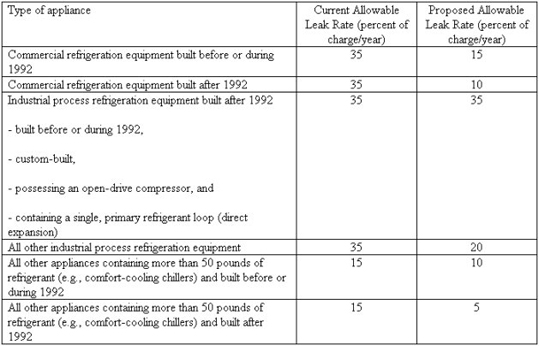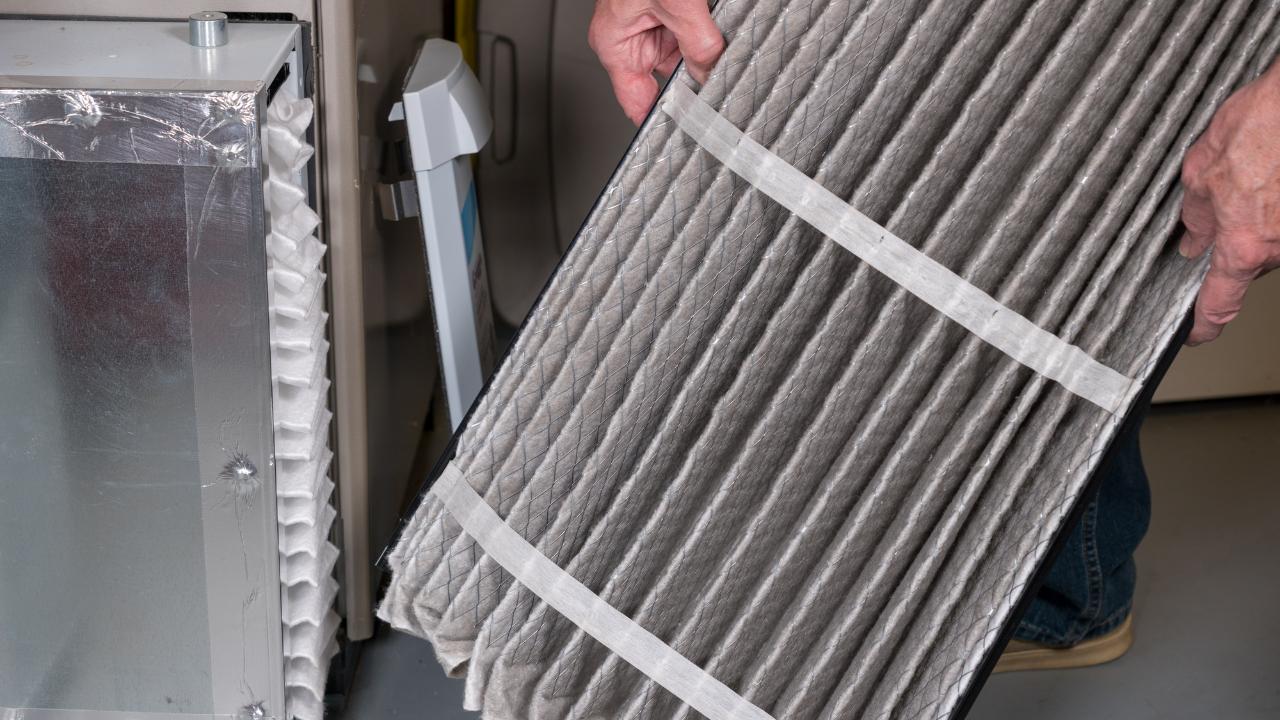Achieving “Near Zero” Refrigerant Emissions in HVAC Systems
Robert Johnson, Environmental Support Solutions
Posted 10/13/2022
Introduction
The leak repair requirements, under Title VI Section 608 of the Clean Air Act Amendments of 1990, require that when an owner or operator of an appliance that normally contains a refrigerant charge of more than 50 pounds discovers that it is leaking at a rate that would exceed the applicable trigger rate during a 12-month period, the owner or operator must take corrective action. The Clean Air Act also requires that refrigerant emissions vented into the atmosphere during installation, service or retirement of equipment be minimized.
Trigger Rates
For all appliances that have a refrigerant charge of more than 50 pounds, the following leak rates for a 12-month period are applicable:
- commercial refrigeration 35%
- industrial process refrigeration 35%
- comfort cooling 15%
- all other appliances 15%
| Proposed Maximum Permissable Leak Rates |

Chiller Leak Prevention
Chillers and their refrigerants require ongoing preventative maintenance. Preventing refrigerant from leaving, preventing air from entering, and preserving quality are all a part of chiller maintenance. By maintaining your chillers and by preventing chiller leaks you will also keep your operating costs down.
Plant personnel should perform monitoring procedures daily to minimize refrigerant discharge into the atmosphere. For machines with refrigerants operating below atmospheric pressure, technicians should check and log the purge system pump-out rate. Other items to be logged daily include system supply and return water temperatures, as well as refrigerant temperatures, levels and pressures.
Look for “Evidence” and/or “Signs” of Leaks
Technicians should check the vane operator shaft, bearings and joints, and drain the drip leg from the rupture disk discharge line for oil seepage. Negative pressure machines such as those using HCFC-123 should undergo maintenance, including compressor valve plate replacement, and cleaning of the purge oil separator, purge drum and purge condensing coil. This annual maintenance also should include changing the purge oil and replacing the purge valve seat as applicable.
Typically, chiller refrigerant oil was changed annually, but the modern practice is to take a sample of the oil to a laboratory to determine when the oil change is actually required. The laboratory typically will check the oil for moisture, acid and metals.
Minimizing oil changes is desirable, as refrigerant is dissolved in the oil and could be released into the atmosphere when the oil is discarded. Vacuum recovery units can reclaim refrigerants that would have otherwise been lost in the oil change process.
Any technician performing an oil change must be certified to work with refrigerants, and they must dispose of all waste oil in compliance with applicable environmental regulations. Technicians also should replace the oil filter along with the oil, or more frequently if excessive differential pressure readings across it dictate.
Tube check
Technicians also should check chiller condenser tubes annually and evaporator tubes on closed systems should be checked every three years. If tubes need cleaning and the interiors of the tubes are smooth bore, technicians can remove the sludge with bristle brushes attached to long metal rods. If the tubes contain interior baffles, contact the chiller manufacturer’s representative for information on how to clean their interiors.
After the brush cleaning, flush the tubes with clean water. Scale deposits are cleaned chemically, typically by the water treatment contractor. Proper water treatment including chemicals and metering pumps in the condenser line minimizes the need to clean fouled condenser water tubes. Cooling tower sumps also must be kept treated and clean.
If proper chemical treatment of the condenser and cleaning of the tubes has not been performed, then the tubes may be pitted and need replacement.
Operations log
The importance of a log system cannot be over emphasized, as it can provide early detection of deteriorating conditions, inefficient operations, and refrigerant leaks.
Minimizing Leaks Requires Leak Management Plan
Restrictions on refrigerant releases and regulations on mandatory leak repairs have made chiller leak management and conservation more important than ever. Maintenance engineers must be properly trained, and must know what the specific regulations and requirements are in order to effectively manage leaks and comply with EPA requirements.
While any maintenance engineer who services or oversees chillers should be knowledgeable about traditional preventive maintenance procedures for chillers, as well as steps to minimize refrigerant discharge, some of the maintenance steps that involve refrigerant handling and transfer must be performed by technicians who are specially trained and EPA certified to do such work. Penalties for letting uncertified personnel service refrigeration equipment are substantial. Implementing a defined Leak Management Program that incorporates regulatory requirements and good maintenance practices is one of the key components of successful refrigerant compliance management.
What Actions Should a Maintenance Professional Take?
Today, the new regulations, rising prices of refrigerants, and reduction of energy efficiency of improperly charged refrigerant chillers demand a more comprehensive and sophisticated approach to refrigerant conservation and leak management. A Leak Management Program should include the following:
- Conduct an Inventory of Equipment and Refrigerants
- Develop a Leak Management Plan
- Implement a Refrigerant Recordkeeping System
- Maintain Existing Equipment and Refrigerant Supplies
- Replace Old or Inefficient Equipment
Conduct an Inventory of Equipment and Refrigerants
Detailed records of equipment stocks and refrigerant are essential for making informed decisions about usage and leak management. Priority should be given to equipment with the largest charge. Inventory sheets should individually list chillers and pieces of commercial refrigeration equipment. Information is needed on the manufacturer, model, serial number, year installed, capacity in tons, charge size, leak rates (based on records of recharging or ‘topping off’), refrigerant, and location. Small appliances–such as household refrigerators and window air conditioners, package units, vending machines, water coolers, and ice machines should–also be inventoried and can be recorded as groups.
The quantity purchased, consumed, disposed, or reclaimed should be monitored and analyzed. Refrigerant inventories should be kept by type and should include the volume contained in each piece of existing equipment, as well as amounts that are currently stored. These inventories should be updated regularly. Local codes for storage limits should be consulted.
Develop a Leak Management Plan
A good plan is based on accurate equipment and refrigerant inventories and usage. The plan should address compliance with applicable laws and regulations, continued supplies and service, reduced emissions, and recovery/ recycling. The plan should emphasize responsible handling practices.
Company’s polices and procedures regarding each of the following issues should be included:
- Refrigerant purchase, sales and disposal
- Safe transport of refrigerants
- Refrigerant tracking and record keeping
- Contaminated refrigerant guidelines
- leak testing, leak prevention and leak repairs
- Equipment and refrigerant inventory
- Refrigerant storage
- Certification for technicians
- Penalties for noncompliance
- Compliance audits and surveys
- Refrigerant recovery, recycling, and reclaiming
- Servicing practices
- Refrigerant cylinder handling
- Venting and losses.
Reduce Operating Costs
Operational costs can rise without proper refrigerant management. As refrigerant quality drops, the compressor must work harder, drawing more power. The same applies to inadequate quantities of refrigerant. Overcharged chillers face an even greater risk of compressor damage than undercharged chillers.
With such a high value and impact on operations, it would seem reasonable to expect that steps be taken to maintain refrigerant quality and containment to avoid replacement.
Refrigerant management should include steps to ensure the refrigerant’s quality and to keep the chiller as tight as possible.
Facilities must contain, convert or replace the CFCs in their chillers. Facilities should not be reluctant to start the replacement or retrofit of their chillers. With increased enforcement activity by the EPA, non-compliance can result in fines and penalties of up to $27,500 per day in civil penalties, up to 5 years federal imprisonment for knowing or willful violations, and up to two years imprisonment for submission of false records.
Robert Johnson, Environmental Support Specialists
Related Articles

Engineered Building Maintenance

HVAC Attack - How to Select the Right HVAC Filter for the Job

How Building Managers Can Save On Energy Purchasing Through Changing Paradigms

What Is Facilities Management? Challenges, Solutions, & More

How a Platform Approach Can Transform Your Building Operations




